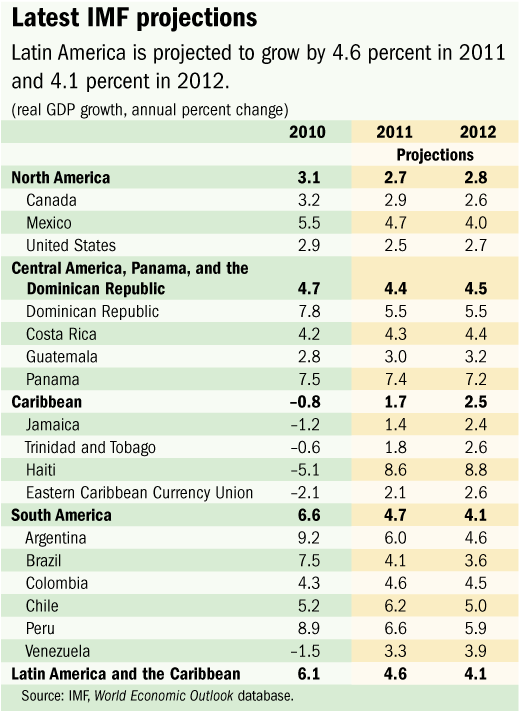
Typical street scene in Santa Ana, El Salvador. (Photo: iStock)
IMF Survey: Despite Mild Global Slowdown, Latam Growth Still Strong
June 17, 2011
- 4½ percent growth predicted for Latin America and Caribbean in 2011
- High commodity prices, easy financing conditions are fueling domestic demand
- Main challenge is to contain inflation, prevent boom-bust cycle
Latin America’s growth, expected to exceed 4½ percent in 2011, remains robust, driven by high commodity prices and easy external financing conditions, but early signs of overheating are appearing, the IMF said in its latest global update.

Auto worker near São Paulo, Brazil: the expansion has been strongest in South America (photo: Naco Doce/Newscom)
WEO/GFSR Updates
According to the World Economic Outlook update, released in São Paulo, the expansion has been strongest in South America. But, if left unchecked, this expansion could soon lead to imbalances in the economy, the IMF warned.
As output gaps have closed in much of the region, early signs of overheating are appearing: inflation is rising, current account deficits are widening, and credit and asset prices are growing rapidly. High global fuel and food prices are adding to the challenge of containing inflation and protecting the poor.
“The main economic risk in the case of Latin America is complacency,” said Nicolás Eyzaguirre, head of the IMF’s Western Hemisphere Department, in a May 2011 video interview on the main findings of the Regional Economic Outlook for the Western Hemisphere. “The region is growing a bit beyond its possibilities so if it does not begin to put the brakes on and continues at this pace, economies could eventually overheat,” he added.
Differences in performance
Growth in Latin America and the Caribbean is expected to moderate from just above 6 percent in 2010 to about 4½ percent in 2011 and to converge to its potential rate—about 4 percent—over the next two years (see table). The expansion will continue to be led by domestic demand. These projections assume a significant withdrawal of policy stimulus and some deceleration of private sector demand, the IMF said.
Activity in the economies with closer links to advanced economies is finally picking up, despite the lagging recovery in the United States and other advanced economies.
However, growth in many Central American and Caribbean countries will continue to be constrained by the slow recovery in remittances and tourism and less favorable terms of trade. High public debt is also one of the most difficult issues facing Caribbean countries. At a conference convened to explore the Caribbean’s challenges and policy options, participants put forward a number of innovative ideas to manage the region’s debt.
Risks to the near-term outlook
Although downside risks persist for the world economy, risks for the near-term outlook in Latin America are somewhat more balanced, the IMF said. GDP growth could be higher if the assumed policy tightening does not materialize or proves insufficient to slow domestic demand.
On the downside, a serious tightening in global financial conditions could, through its impact on global growth and commodity prices, adversely affect prospects in the region. A reversal in capital flows to the region could amplify such impact.
Optimal policy mix
With output gaps closed in most countries, the IMF said countries should remove policy stimulus on a timely basis. Even though many countries have moved in recent months to raise policy interest rates, it is still critical to continue to adjust the policy mix by reducing the pace of government spending to avoid placing an excessive burden on monetary policy in the context of sizeable capital inflows and currency appreciation.
In light of strong credit and asset price growth, countries should also continue to strengthen prudential tools and, in some circumstances, could consider using capital controls to enhance the resilience of their financial systems. A recent conference debated the appropriate policy responses to manage capital flows, including capital controls.
In Central America, emphasis must shift to rebuilding the policy buffers used during the global recession, while in the Caribbean, where public debt is very high, fiscal policy will need to continue with consolidation to ensure economic stability and set the stage for sustainable growth in the future.



